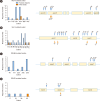Germline Mutations and Phenotypic Associations in Korean Patients With Pheochromocytoma and Paraganglioma: A Multicenter Study and Literature Review
- PMID: 39069753
- PMCID: PMC11375186
- DOI: 10.3343/alm.2023.0376
Germline Mutations and Phenotypic Associations in Korean Patients With Pheochromocytoma and Paraganglioma: A Multicenter Study and Literature Review
Abstract
Genetic testing is recommended for all patients with pheochromocytomas and paragangliomas (PPGL) to establish genotype-phenotype associations. We investigated germline mutations in 59 patients with PPGL at six Korean university hospitals using next-generation sequencing (NGS) targeting 38 PPGL-associated genes, including those recommended by the Korean PPGL Task Force. Germline mutations were identified in 13 patients (22%), and affected four genes: RET, NF1, VHL, and SDHD. Germline mutations were significantly associated with a family history of PPGL, smaller tumor size, and the presence of other types of tumors. Using 95 Korean PPGL cases with germline mutations identified through a literature review and 13 cases from our cohort, we characterized genotype-phenotype correlations. Mutation hotspots were identified in specific codons of RET (codons 631 and 634), VHL (157 and 167), and SDHB (131 and 253). NF1 mutations varied, indicating the absence of common hotspots. These findings highlight the efficacy of the recommended NGS panel for Korean patients with PPGL and the importance of genetic testing in establishing clinical management and personalized therapeutic strategies.
Keywords: Genotype; Germline; Korean; Paraganglioma; Phenotype; Pheochromocytoma.
Conflict of interest statement
None declared.
Figures

Similar articles
-
Germline mutations and genotype-phenotype correlations in patients with apparently sporadic pheochromocytoma/paraganglioma in Korea.Clin Genet. 2014 Nov;86(5):482-6. doi: 10.1111/cge.12304. Epub 2013 Nov 15. Clin Genet. 2014. PMID: 24134185
-
Genetic Analysis and Clinical Characteristics of Hereditary Pheochromocytoma and Paraganglioma Syndrome in Korean Population.Endocrinol Metab (Seoul). 2020 Dec;35(4):858-872. doi: 10.3803/EnM.2020.683. Epub 2020 Dec 23. Endocrinol Metab (Seoul). 2020. PMID: 33397040 Free PMC article.
-
Germline mutations and genotype-phenotype correlation in Asian Indian patients with pheochromocytoma and paraganglioma.Eur J Endocrinol. 2016 Oct;175(4):311-23. doi: 10.1530/EJE-16-0126. Eur J Endocrinol. 2016. PMID: 27539324
-
An overview of 20 years of genetic studies in pheochromocytoma and paraganglioma.Best Pract Res Clin Endocrinol Metab. 2020 Mar;34(2):101416. doi: 10.1016/j.beem.2020.101416. Epub 2020 Mar 10. Best Pract Res Clin Endocrinol Metab. 2020. PMID: 32295730 Review.
-
Testing for germline mutations in sporadic pheochromocytoma/paraganglioma: a systematic review.Clin Endocrinol (Oxf). 2015 Mar;82(3):338-45. doi: 10.1111/cen.12530. Epub 2014 Jul 7. Clin Endocrinol (Oxf). 2015. PMID: 24954084
References
-
- Toledo RA, Burnichon N, Cascon A, Benn DE, Bayley JP, et al. NGS in PPGL (NGSnPPGL) Study Group, author. Consensus Statement on next-generation-sequencing-based diagnostic testing of hereditary phaeochromocytomas and paragangliomas. Nat Rev Endocrinol. 2017;13:233–47. doi: 10.1038/nrendo.2016.185. - DOI - PubMed
Publication types
MeSH terms
Substances
LinkOut - more resources
Full Text Sources
Medical
Research Materials
Miscellaneous

